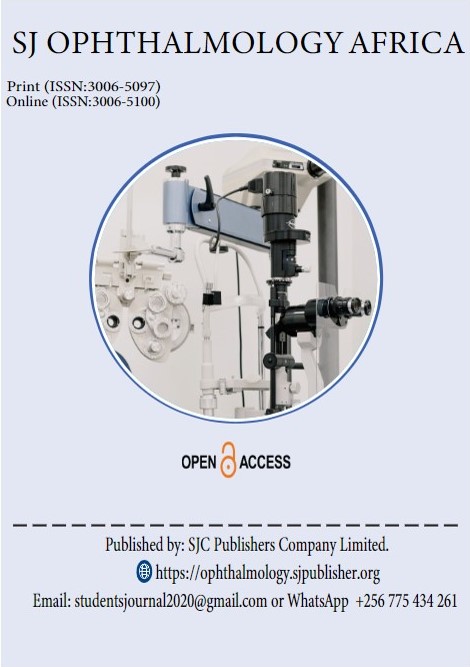FACTORS ASSOCIATED WITH THE PREVALENCE OF ALLERGIC CONJUNCTIVITIS AMONG PATIENTS RECEIVING EYE CARE SERVICES IN JINJA REGIONAL REFERRAL HOSPITAL EYE CLINIC. A CROSS-SECTIONAL STUDY.
DOI:
https://doi.org/10.51168/67jyne76Keywords:
Allergic Conjunctivitis, Eye Care Services, Jinja Regional Referral Hospital, Eye ClinicAbstract
The purpose of the study
To determine the prevalence and associated factors of allergic Conjunctivitis among patients attending the eye clinic at Jinja Regional Referral Hospital.
Methods
This was a cross-sectional study design employing quantitative methods of data collection. The study area was the eye clinic of Jinja RRH.
Results
The study revealed that in the prevalence of allergic conjunctivitis, the majority 55/72 (76%) was seen mostly in children and only 17/72 (24%) were adults. The majority 58/72 (80%) of the respondents were living in dust places while 14/72 (19.4%) were not living in a dust place. The majority 48/72 (66.7%) of the respondents agreed that environmental allergen exposure was a factor contributing to allergic conjunctivitis while the least 24/72 (33.3%) disagreed. On the weather condition of the respondents, the majority 53/72 (73.6%) agreed while 19/72 (26.4%) disagreed that weather conditions could not bring about allergic conjunctivitis among patients. The majority, 43/72 (59.7%) of the respondents agreed that occupational exposure was also contributing to allergic conjunctivitis and the least 29/72 (40.3%) disagreed. Regarding airborne irritants, the majority, 52/72 (72.2%) of respondents agreed that it is a factor that contributes to allergic conjunctivitis among patients while the least disagreed 20/72 (27.8%) disagreed.
Conclusion
Children have been found to have a higher prevalence compared to adults, which can be attributed to factors such as immature immune systems, increased exposure to allergens, and higher susceptibility to environmental triggers.
Recommendations:
Environmental Control Measures should be put in place to reduce exposure to environmental triggers such as dust, pollen, and airborne irritants. This should include regular cleaning and dusting of living spaces, using air purifiers, minimizing outdoor activities during high pollen seasons, and avoiding exposure to known irritants or allergens.
Downloads
Published
Issue
Section
License
Copyright (c) 2024 Richard Ssentongo, Violet Alimwenda (Author)

This work is licensed under a Creative Commons Attribution-NonCommercial-NoDerivatives 4.0 International License.

